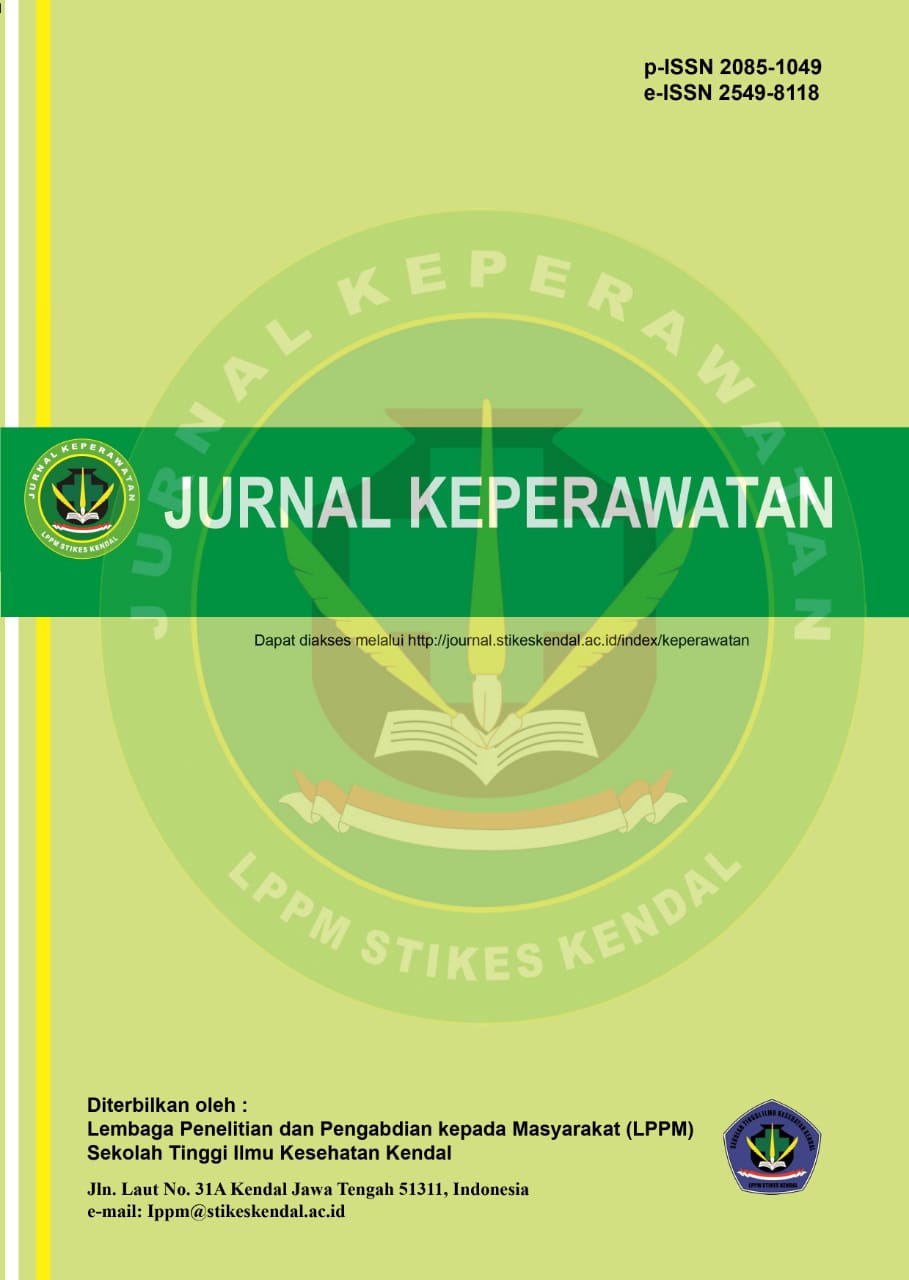The Effect of Telerehabilitation to Improve Quality of Life in Patient of Heart Failure (HF)
DOI:
https://doi.org/10.32583/keperawatan.v15i1.698Keywords:
heart failure, telerehabilitation, telemonitoring, quality of lifeAbstract
Heart failure is one of the biggest causes of death worldwide. The fragility of heart failure patients becomes more vulnerable and at greater risk of physical, functional, cognitive, and emotional decline leading to decreased quality of life. Telerehabilitation provides rehabilitation services at a distance through information technology and telecommunications, such as telephone, internet, and video conferencing conducted at the patient's home as an effective and safe complementary alternative in improving the quality of life. This study aimed to determine the quality of life before and after the implementation of Telerehabilitation. A quasi-experimental study of a single group. A purposive sampling technique was used to collect the data, with a sample of 17 respondents. Data was collected using a Minnesota Living with Heart Failure Questionnaire (MLHFQ) before and after the intervention. The statistical test used was Paired Sample T Test. Heart failure patients will carry out a telerehabilitation program that has been agreed upon by the nurse and doctor. The results of the Paired Sample T Test Quality of Life above show the P value (Sig. 2-tailed) 0.00 or less than 0.005 (<0.05), so it can be concluded that the implementation of Telerehabilitation affects improving the quality of life in Heart Failure patients.
References
Brouwers, R. W. M., van Exel, H. J., van Hal, J. M. C., Jorstad, H. T., de Kluiver, E. P., Kraaijenhagen, R. A., Kuijpers, P. M. J. C., van der Linde, M. R., Spee, R. F., Sunamura, M., Uszko-Lencer, N. H. M. K., Vromen, T., Wittekoek, M. E., & Kemps, H. M. C. (2020). Cardiac telerehabilitation as an alternative to centre-based cardiac rehabilitation. Netherlands Heart Journal, 28(9), 443–451. https://doi.org/10.1007/s12471-020-01432-y
Cavalheiro, A. H., Silva Cardoso, J., Rocha, A., Moreira, E., & Azevedo, L. F. (2021). Effectiveness of Tele-rehabilitation Programs in Heart Failure: A Systematic Review and Meta-analysis. Health Services Insights, 14. https://doi.org/10.1177/11786329211021668
Erdian. 2009. Ilmu Perilaku. Cetakan Pertama. Jakarta: CV Sagung Seto. Hal. 1-122
Gonzalez, D. G. (2016). The Effects of Congestive Heart Failure on Quality of Life: As Evaluated by the Minnesota Living with Heart Failure Questionnaire. http://scholarworks.uark.edu/nursuht/50
KEMENKES. (2021). PROFIL KESEHATAN INDONESIA TAHUN 2020. http://www.kemkes.go.id
Madigan, E., Schmotzer, B. J., Struk, C. J., DiCarlo, C. M., Kikano, G., Piña, I. L., & Boxer, R. S. (2013). Home Health Care With Telemonitoring Improves Health Status for Older Adults With Heart Failure. Home Health Care Services Quarterly, 32(1), 57–74. https://doi.org/10.1080/01621424.2012.755144
Mizukawa, M., Moriyama, M., Yamamoto, H., Rahman, M., Naka, M., Kitagawa, T., Kobayashi, S., Oda, N., Yasunobu, Y., Tomiyama, M., Morishima, N., Matsuda, K., & Kihara, Y. (2019). Nurse-led collaborative management using telemonitoring improves quality of life and prevention of rehospitalization in patients with heart failure a pilot study. International Heart Journal, 60(6), 1293–1302. https://doi.org/10.1536/ihj.19-313
Ong, M. K., Romano, P. S., Edgington, S., Aronow, H. U., Auerbach, A. D., Black, J. T., de Marco, T., Escarce, J. J., Evangelista, L. S., Hanna, B., Ganiats, T. G., Greenberg, B. H., Greenfield, S., Kaplan, S. H., Kimchi, A., Liu, H., Lombardo, D., Mangione, C. M., Sadeghi, B., … Yan, T. (2016). Effectiveness of remote patient monitoring after discharge of hospitalized patients with heart failure the better effectiveness after transition-heart failure (BEAT-HF) randomized clinical trial. JAMA Internal Medicine, 176(3), 310–318. https://doi.org/10.1001/jamainternmed.2015.7712
RISKESDAS. (2013). LAPORAN NASIONAL RISKESDAS 2013. https://pusdatin.kemkes.go.id/resources/download/general/Hasil%20Riskesdas%202013.pdf
RISKESDAS. (2018a). LAPORAN NASIONAL RISKESDAS 2018. www.litbang.depkes.go.id
RISKESDAS. (2018b). LAPORAN PROVINSI SULAWESI SELATAN. https://drive.google.com/drive/folders/1XYHFQuKucZIwmCADX5ff1aDhfJgqzI-l
Rohde, L. E., Hoffmann Filho, C. R., Rover, M. M., Rabelo-Silva, E. R., Lopez, L., Passos, L. C. S., Silvestre, O. M., Martins, S. M., de Figueiredo Neto, J. A., Silveira, F. S., Canesin, M. F., Simões, M. v., Akio Nishijuka, F., Bertoldi, E. G., Danzmann, L. C., Mourilhe-Rocha, R., Magedanz, E. H., Esteves, M., de Castilho, F. M., … Ramirez, F. (2021). Design of a multifaceted strategy based on automated text messaging in patients with recent heart failure admission. ESC Heart Failure, 8(6), 5523–5530. https://doi.org/10.1002/ehf2.13516
Santrock , J. (2014). Educational Psychology (5 ed.). (H. Bhimasena, Trans.) Jakarta: Salemba Humanika.
Seto, E., Leonard, K. J., Cafazzo, J. A., Barnsley, J., Masino, C., & Ross, H. J. (2012). Mobile phone-based telemonitoring for heart failure management: A randomized controlled trial. Journal of Medical Internet Research, 14(1). https://doi.org/10.2196/jmir.1909
WHO. (2020). WORLD HEALTH STATISTICS 2020 (MONITORING HEALTH FOR THE SDGs). https://apps.who.int/iris/bitstream/handle/10665/332070/9789240005105-eng.pdf
WHO. (2021). WORLD HEALTH STATISTICS 2021 (MONITORING HEALTH FOR THE SDGs). https://apps.who.int/iris/bitstream/handle/10665/342703/9789240027053-eng.pdf
WHOQOL. (2012). Programme On Mental Health: WHOQOL User Manual. https://www.who.int/tools/whoqol.
Downloads
Published
How to Cite
Issue
Section
License
Copyright (c) 2023 Jurnal Keperawatan

This work is licensed under a Creative Commons Attribution-NonCommercial-NoDerivatives 4.0 International License.




